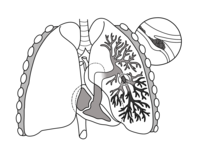
Photo from wikipedia
The resent pandemic of the 2019 novel coronavirus disease (COVID-19) is challenging medical institutions around the world. Management of severe acute respiratory symptoms (SARS) caused by the novel corona virus… Click to show full abstract
The resent pandemic of the 2019 novel coronavirus disease (COVID-19) is challenging medical institutions around the world. Management of severe acute respiratory symptoms (SARS) caused by the novel corona virus often includes intensive care and invasive ventilation. One important complication associated with COVID-19 disease and a potential differential diagnosis in sudden respiratory distress is pulmonary embolism (PE). A retrospective cohort study by Zhou et al. demonstrated respiratory failure to be the most common complication with 54% of the patients leading transfers to the Intensive Care Unit and death. Severe coagulopathy was present in 19%, but rates differed significantly between survivors (7%) and non-survivors (50%) [1]. This phenomenon is already well known in interalia influenza-associated pneumonia and leads to a predisposition for ischemic events and thrombosis [2]. On this basis, recent data open the discussion of anticoagulation in severe cases of COVID-19 as treatment with low-molecular-weight heparin (LMWH) appeared to be associated with reduced mortality [3]. Therefore, the International Society of Thrombosis and Hemostasis (ISTH) recently published the recommendation that all patients hospitalized for COVID-19 should receive a prophylactic dose of LMWH during hospitalization, in the absence of any contraindications such as active bleeding or platelet counts of less than 25 × 10/l [4]. The current gold standard to rule out significant PE in patients with COVID-19 pneumonia is a contrast-enhanced CTscan (ceCT). Several case reports have been published that could confirm PE in patients with typical COVID-19associated pulmonary changes [5, 6]. However, in patients with contraindications for iodinated contrast media, ceCTcannot be used to rule out PE. A potential alternative to ceCT for this indication is perfusion single-photon emission tomography (SPECT) using [Tc]-labeledmacroaggregated albumin (MAA). Due to the high risk of aerosol production associated with ventilation ([Tc]-labeled aerosols) scans, the Society of Nuclear Medicine of Northern America discouraged the use of classic imaging combination of ventilation-perfusion in patients with COVID-19 in a recent communication by Zuckier et al. [7]. Ventilation scans should be omitted in any patient with known or suspected COVID-19 infection; therefore, a chest X-ray based algorithm was proposed, with perfusion only SPECT scans in patients without pulmonary opacities. This excludes all patients with pulmonary infiltrates and therefore the majority of patients with critical illness associated with COVID-19. As presented in the image of the month of the current issue, we believe that the combination of low-dose CT and [Tc]MAASPECTcan be used to rule out significant PEwith careful analysis of the CT component to rule out infiltrates of emphysema in areas of reduced perfusion. In fact, patients with pulmonary infiltrates show stronger perfusion in the non-affected lung areas. As a result, clots should be expected in vessels of non-affected pulmonary segments. This can be observed in This article is part of the Topical Collection on Infection and Inflammation
Journal Title: European Journal of Nuclear Medicine and Molecular Imaging
Year Published: 2020
Link to full text (if available)
Share on Social Media: Sign Up to like & get
recommendations!